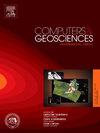Deep learning assisted denoising of fast polychromatic X-ray micro-CT imaging of multiphase flow in porous media
IF 4.4
2区 地球科学
Q1 COMPUTER SCIENCE, INTERDISCIPLINARY APPLICATIONS
引用次数: 0
Abstract
Understanding the flow of fluids in the subsurface and their interaction with different solid surfaces is crucial for addressing challenging geological applications such as CO2 sequestration, enhanced oil recovery, and environmental remediation of polluted aquifers. Synchrotron-based 3D X-ray micro-computed tomography (micro-CT) has enabled the visualization of dynamic pore-filling events in multiphase flow experiments at sub-second time resolutions. However, the limited accessibility of synchrotron facilities has driven the use of low-flux polychromatic micro-CT systems, which often produce relatively noisy images during fast scans. To overcome this limitation, we propose a deep learning workflow using a cycleGAN network trained on unpaired datasets as no direct pixel-wise correspondence exists between the noisy domain and the high-quality domain. This approach transforms noisy fast polychromatic micro-CT scans into high-quality images, enabling detailed analysis of multiphase flow dynamics. The effectiveness of the denoising process was verified using blind image quality evaluators and Minkowski functionals for the non-wetting phases. The results indicate that the cycleGAN network achieves an average 1 to 6 percentage error difference for 3D morphological analysis parameters and outperforms other filtering methods such as non-local means and the adaptive Weiner filter, demonstrating its potential as a reliable technique for restoring noisy fast scans from polychromatic micro-CT systems.
深度学习辅助多孔介质中多相流快速多色x射线微ct成像去噪
了解地下流体的流动及其与不同固体表面的相互作用对于解决具有挑战性的地质应用至关重要,例如二氧化碳封存、提高石油采收率和污染含水层的环境修复。基于同步加速器的三维x射线微计算机断层扫描(micro-CT)能够以亚秒级的时间分辨率可视化多相流实验中的动态孔隙填充事件。然而,同步加速器设施的有限可及性促使了低通量多色微型ct系统的使用,这些系统在快速扫描期间经常产生相对嘈杂的图像。为了克服这一限制,我们提出了一种深度学习工作流,使用在未配对数据集上训练的cycleGAN网络,因为噪声域和高质量域之间不存在直接的像素对应关系。该方法可将嘈杂的快速多色微ct扫描图像转换为高质量图像,从而实现多相流动力学的详细分析。使用盲图像质量评估器和非润湿阶段的Minkowski函数验证了去噪过程的有效性。结果表明,cycleGAN网络在3D形态分析参数上实现了平均1到6个百分点的误差差异,并且优于其他滤波方法,如非局部均值和自适应Weiner滤波器,证明了它作为一种可靠的技术,可以从多色微ct系统中恢复有噪声的快速扫描。
本文章由计算机程序翻译,如有差异,请以英文原文为准。
求助全文
约1分钟内获得全文
求助全文
来源期刊

Computers & Geosciences
地学-地球科学综合
CiteScore
9.30
自引率
6.80%
发文量
164
审稿时长
3.4 months
期刊介绍:
Computers & Geosciences publishes high impact, original research at the interface between Computer Sciences and Geosciences. Publications should apply modern computer science paradigms, whether computational or informatics-based, to address problems in the geosciences.
 求助内容:
求助内容: 应助结果提醒方式:
应助结果提醒方式:


